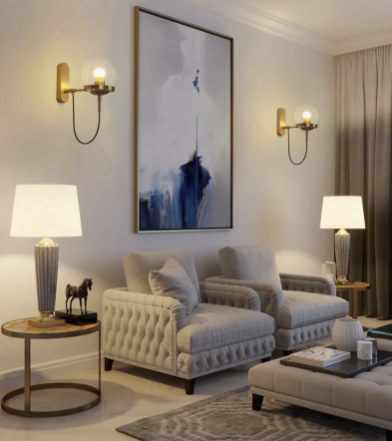Wall lights, often referred to as sconces or wall-mounted fixtures, have become an integral part of modern interior design. These versatile lighting solutions not only illuminate spaces but also serve as decorative elements that enhance the overall aesthetic of a room. Unlike traditional overhead lighting, wall lights provide a unique opportunity to create layered lighting effects, allowing homeowners to highlight specific areas or features within a space.
Their ability to blend functionality with style makes them a popular choice for various settings, from cozy living rooms to elegant dining areas. The history of wall lighting Ckensu can be traced back to ancient civilizations, where torches and oil lamps were affixed to walls for illumination. Over the centuries, the design and technology of wall lights have evolved significantly.
Today, they come in a myriad of styles, materials, and finishes, catering to diverse tastes and preferences. Whether one is drawn to the sleek lines of contemporary designs or the ornate details of vintage-inspired fixtures, there is a wall light to suit every decor theme. As we delve deeper into the world of wall lights, it becomes evident that these fixtures are not merely functional; they are also powerful tools for transforming the ambiance of any room.
Choosing the Right Wall Lights for Your Living Room
Choosing the Right Wall Lights for Your Living Room
Selecting the perfect wall lights for your living room involves considering several key factors, including the size of the space, the existing decor, and the intended use of the lighting. A well-lit living room should strike a balance between functionality and aesthetics.
Functionality and Lighting Needs
The intended use of the lighting plays a significant role in determining the type of wall lights to choose. For instance, if the living room is primarily used for relaxation and entertainment, softer, warmer light tones may be more suitable. In contrast, if the space is often used for reading or other tasks requiring focused light, brighter fixtures with adjustable brightness may be necessary.
Scale, Proportion, and Style
When choosing wall lights, it is essential to consider the scale and proportion of the fixtures in relation to the room. Oversized sconces can overwhelm a small space, while tiny fixtures may get lost in a larger room. Additionally, the style of the wall lights should complement existing furniture and decor elements. For example, if your living room features mid-century modern furniture, sleek and minimalist wall lights with geometric shapes would harmonize beautifully. Conversely, if your decor leans towards a more traditional aesthetic, ornate sconces with intricate detailing may be more appropriate.
Placement and Installation of Wall Lights
The placement of wall lights is crucial in achieving the desired effect in your living room. A common guideline is to install sconces at eye level, typically around 60 to 66 inches from the floor. This height ensures that the light is both functional and visually appealing.
However, this can vary based on the specific design of the fixture and the overall layout of the room. For instance, if wall lights are being used to highlight artwork or architectural features, they may need to be positioned higher or lower depending on what they are illuminating. In terms of installation, it is advisable to consult with a professional electrician, especially if you are unfamiliar with electrical work.
Proper installation not only ensures safety but also maximizes the effectiveness of the lighting. Additionally, considering the wiring and electrical layout of your home is essential before making any decisions about placement. If you are looking for flexibility in your lighting design, consider using wall lights with adjustable arms or dimmable features that allow you to modify the intensity and direction of light as needed.
Stylish and Functional Wall Light Designs
The design of wall lights has expanded dramatically over recent years, offering an array of options that cater to various tastes and functional needs. From minimalist designs that emphasize clean lines and simplicity to elaborate fixtures that serve as statement pieces, there is no shortage of choices. For example, industrial-style wall lights often feature raw materials such as metal and exposed bulbs, creating a rugged yet stylish look that complements urban lofts or modern homes.
On the other hand, more traditional designs may incorporate elements such as crystal embellishments or intricate metalwork. These fixtures can add a touch of elegance and sophistication to a living room while providing ambient lighting. Additionally, there are eco-friendly options available that utilize LED technology, which not only reduces energy consumption but also offers longevity compared to traditional incandescent bulbs.
The versatility in design allows homeowners to select wall lights that not only meet their lighting needs but also reflect their personal style.
Creating Ambiance with Wall Lights
Wall lights play a pivotal role in setting the mood within a living room. The right lighting can transform a space from bright and energetic to warm and inviting with just a flick of a switch. To create ambiance effectively, consider layering different types of lighting: ambient, task, and accent.
Wall lights can serve as ambient lighting when used in conjunction with other light sources such as floor lamps or ceiling fixtures. This layered approach allows for greater control over the overall brightness and atmosphere of the room. Accent lighting is another way to utilize wall lights creatively.
By strategically placing sconces near artwork or architectural features, you can draw attention to these elements while adding depth to the space. Dimming capabilities can further enhance this effect; being able to adjust the brightness allows you to tailor the ambiance for different occasions—whether it’s a lively gathering with friends or a quiet evening spent reading by yourself. The interplay between light and shadow created by wall lights can add texture and interest to your living room design.
Maintenance and Care for Wall Lights
Importance of Maintenance for Wall Lights
Maintaining wall lights is essential for ensuring their longevity and optimal performance. Regular cleaning is necessary to prevent dust accumulation that can dull their appearance and reduce light output. Depending on the material of your wall lights—be it metal, glass, or fabric—the cleaning method may vary.
Cleaning Methods for Different Materials
For glass fixtures, a gentle glass cleaner can restore clarity and shine, while metal sconces may require a soft cloth and mild soap solution to remove tarnish without scratching the surface. In addition to cleaning, it’s important to periodically check the electrical components of your wall lights. This includes inspecting wiring for any signs of wear or damage and ensuring that bulbs are functioning correctly.
Replacing Bulbs and Ensuring Safety
Replacing burnt-out bulbs promptly not only maintains the aesthetic appeal but also ensures safety by preventing overheating issues associated with faulty fixtures. By taking these simple maintenance steps, you can keep your wall lights looking beautiful and functioning effectively for years to come.
Enhancing Your Home’s Ambiance with Wall Lights
By carefully selecting designs that complement your decor and strategically placing them throughout your living room, you can achieve a harmonious balance between style and practicality. With proper maintenance and care, these versatile lighting solutions will continue to enhance your home’s ambiance for many years ahead.


